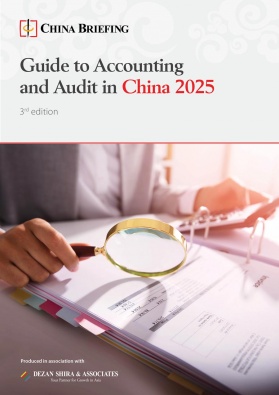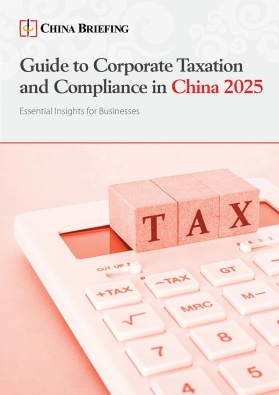Additional Compliance After Completing China’s Annual CIT Filing
Following the deadline for China’s annual corporate income tax (CIT) Filing, there are certain compliance points that businesses should still pay attention to. In this article, we explain the importance of retaining supporting documents and collecting and preserving relevant documentation for asset loss deductions to enjoy continued access to tax incentives.
After a busy time of dealing with the annual compliance requirements, including preparing the audit report, conducting annual CIT filing (also called Annual CIT reconciliation or annual CIT settlement), and filing the “many-in-one” annual reporting, businesses may think it’s time to finally take a breath. However, there are still some compliance points that taxpayers should pay attention to, according to.
In this article, we provide reminders regarding the retention of supporting documents for tax incentives and the collection and preservation of documentation related to asset loss deductions. Additionally, we offer some practical tips for retaining relevant records.
Reminder 1: Retention of supporting documents for tax incentives
Throughout the year and during the annual CIT reconciliation, businesses may have enjoyed various tax incentives based on their own situation, such as the CIT exemption or reductions on certain types of incomes, additional pre-tax deduction of certain expenses, reduced CIT rates, preferential tax policies for small companies, and so on.
Under China’s current tax regulations, for most preferential tax policies, taxpayers can self-assess if they are qualified to access the incentives and apply them when making the tax payment (that is, the time of pre-payment or final settlement, depending on the specific incentive) – without seeking approval from the local tax bureau. However, this does not mean taxpayers can enjoy tax incentives at will, either. Among others, taxpayers must retain relevant documents for potential inspection by the tax bureaus.
Besides, for taxpayers enjoying preferential CIT treatments provided to the integrated circuit enterprises and software enterprises (excluding those subject to catalog management), companies should also submit the required documents to the tax authorities after completing the annual CIT reconciliation.
What are the supporting documents?
The supporting documents refer to specific materials, such as contracts, agreements, vouchers, certificates, files, account books, and explanations, that demonstrate the enterprise’s eligibility for preferential treatment.
These are categorized into two types: (i) primary supporting documents, and (ii) other (or secondary) supporting documents.
- Primary supporting documents are prepared by the company based on the listed items in the Catalog of CIT Preferential Policies for Enterprises (企业所得税优惠事项管理目录).
- Other supporting documents are supplemented by the company, according to the specific situation of the preferential treatment received.
If a company simultaneously enjoys multiple preferential treatment advantages or the preferential treatment is calculated separately based on specific projects, the supporting documents should be collected and retained separately for each preferential treatment or project, as per the respective regulatory requirements.
Why is it important to keep accurate records for tax audits and inspections?
Comprehensive and accurate records serve as crucial evidence during tax audits or inspections to validate the eligibility and compliance of tax incentives claimed. Consistent documentation and record-keeping demonstrate the business’s commitment to transparency, minimizing the risk of penalties or disputes. At the same time, well-organized records simplify the process of responding to inquiries from tax authorities and reduce the time and effort required for audits or reviews.
How to prepare the supporting documents?
Enterprises that enjoy tax incentives should, after completing the annual CIT settlement, organize and compile the retained documentation properly for potential inspection by the tax authorities.
If a company simultaneously enjoys multiple preferential treatment advantages or the preferential treatment is calculated separately based on specific projects, the supporting documents should be collected and retained separately for each preferential treatment or project, as per the respective regulatory requirements.
Retention responsibilities under consolidated tax payment
For resident enterprises with non-legal person branches and non-resident enterprises that adopt consolidated tax payment, if certain branches or establishments benefit from preferential tax policies, the head office or main reporting entity is responsible for centrally collecting and retaining the relevant supporting documents.
However, if a branch or a non-resident enterprise’s establishment independently qualifies for preferential treatment under applicable regulations, it should collect and retain its own supporting materials. After completing the annual CIT settlement, these branches or establishments must also submit a list of the retained documents to the head office or main reporting entity for consolidation.
How long should supporting documents be retained?
The materials retained by enterprises for future reference should be kept for 10 years starting from the day following the end of the annual CIT settlement for the year in which the preferential treatment is enjoyed.
Reminder 2: Collection and preservation of documentation for asset loss deductions
Under the current CIT Law, losses incurred by an enterprise during production and business activities are regarded as reasonable expenditure incurred in relation to income and thus can be deducted when calculating CIT taxable income.
To declare deduction of asset losses, the enterprise only needs to fill in the Pre-tax Deduction and Tax Adjustment Statement for Asset Losses (资产损失税前扣除及纳税调整明细表) in their annual CIT return and retain the relevant documentation for potential inspection.
What is the documentation related to asset losses?
The documentation related to asset losses comprises two categories: (i) external evidence with legal effect, and (ii) internal evidence of specific matters.
External evidence with legal effect refers to written documents with legal effect issued by judicial organs, administrative authorities, professional technical appraisal departments, and others, which are related to the asset losses incurred by the enterprise. It mainly includes:
- Judgments or rulings of judicial organs
- Certificates and replies of public security organs regarding the filing or closure of the case
- Certificates of cancellation, revocation, or suspension of business issued by the administration for market regulation
- Bankruptcy liquidation notices or settlement documents of the enterprise
- Official documents issued by administrative authorities
- Appraisal reports from professional technical departments
- Economic appraisal certificates from qualified intermediary organizations
- Arbitration documents issued by the arbitration institutions
- Insurance documents, such as investigation reports and claim calculation documents issued by insurance companies for insured assets
- Other evidence in accordance with legal provisions
Specific internal evidence refers to declarations or statements by enterprises with sound accounting systems and complete internal control systems, which serve as proof or statements of responsibility for asset damage, scrapping, inventory losses, death, deterioration, and other internal matters. It includes:
- Relevant accounting documents and original vouchers
- Asset inventory list
- Business contracts related to relevant economic activities
- Appraisal documents or materials from the internal technical appraisal department of the enterprise
- Internal approval documents and related explanatory notes
- Statement of responsibility and compensation for losses caused by the responsible person’s management responsibilities
- Statement of legal responsibility for the authenticity of specific matters by the legal representative, the person in charge of the enterprise, and the person in charge of finance.
Companies in China should, as required, keep the relevant documentation complete and intact for the corroboration of declared asset loss matters by tax authorities.
Tips on retaining supporting documents
In this section, we provide essential guidelines for identifying, categorizing, and retaining relevant documentation, along with practical tips for effective organization and storage.
Guidelines for identifying and categorizing relevant supporting documents include:
- Reviewing the specific requirements outlined in the tax regulations for each tax incentive to determine the necessary supporting documents.
- Identifying documents, such as contracts, agreements, invoices, receipts, licenses, or certifications, that validate eligibility for the incentive.
- Categorizing the documents based on the specific requirements of each incentive to ensure easy retrieval and reference.
Once properly identified and categorized, relevant documents should be stored and organized in a systematic manner. To do so, companies may benefit from following these steps:
- Establish a structured filing system, either physical or digital, that allows for easy sorting and retrieval of documents.
- Clearly label folders or directories with relevant categories, such as tax incentives, tax years, or specific incentive programs.
- Utilize document management software or cloud-based platforms to centralize and secure electronic copies of supporting documents.
- Implement regular backup procedures to safeguard against data loss or system failures.
In conclusion, taxpayers in China should pay close attention to retaining supporting documents for tax incentives and collecting and preserving documentation related to asset loss deductions, following the indications provided by official authorities, as summarized in this article.
While preparing for next year’s filing, it is also advisable to explore the eligibility of your company for any CIT incentives and reduced rates. Taking advantage of these opportunities can potentially contribute to lowering the company’s tax burden and optimizing the overall tax strategy.
For more information or any tax-related, audit, and compliance queries, feel free to reach out to our China tax and accounting experts at: china@dezshira.com.
About Us
China Briefing is written and produced by Dezan Shira & Associates. The practice assists foreign investors into China and has done so since 1992 through offices in Beijing, Tianjin, Dalian, Qingdao, Shanghai, Hangzhou, Ningbo, Suzhou, Guangzhou, Dongguan, Zhongshan, Shenzhen, and Hong Kong. Please contact the firm for assistance in China at china@dezshira.com.
Dezan Shira & Associates has offices in Vietnam, Indonesia, Singapore, United States, Germany, Italy, India, and Russia, in addition to our trade research facilities along the Belt & Road Initiative. We also have partner firms assisting foreign investors in The Philippines, Malaysia, Thailand, Bangladesh.
- Previous Article China-Germany Economic Relations 2025: What Merz’s Leadership Means for Trade and Investment
- Next Article The China+ Strategy: Cross-Border Restructuring for Supply Chain Resilience








